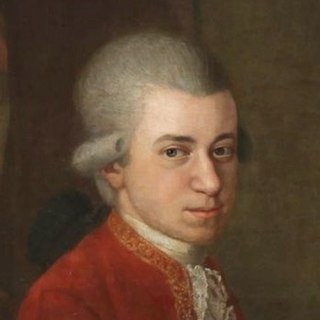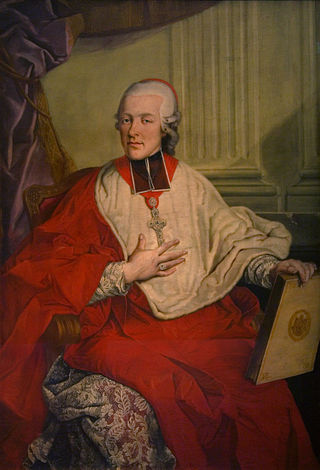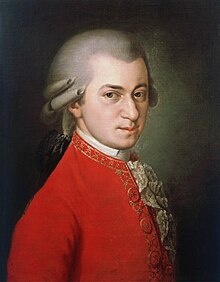
The Symphony No. 36 in C major, K. 425, also known as the Linz Symphony, was written by Wolfgang Amadeus Mozart during a stopover in the Austrian town of Linz on his and his wife's way back home to Vienna from Salzburg in late 1783. The entire symphony was written in four days to accommodate the local count's announcement, upon hearing of the Mozarts' arrival in Linz, of a concert. The première in Linz took place on 4 November 1783. The composition was also premièred in Vienna on 1 April 1784. The autograph score of the "Linz Symphony" was not preserved, but a set of parts sold by Mozart to the Fürstenberg court at Donaueschingen in 1786 does survive.

Symphony No. 35 in D major, K. 385, also known as the Haffner Symphony, was composed by Wolfgang Amadeus Mozart in 1782. It was commissioned by the Haffners, a prominent Salzburg family, for the occasion of the ennoblement of Sigmund Haffner the Younger. The Haffner Symphony should not be confused with the eight-movement Haffner Serenade, another piece Mozart wrote on commission from the same family in 1776.

Symphony No. 20 in D major, K. 133, was composed by Wolfgang Amadeus Mozart in July, 1772, when Mozart was sixteen years old. This symphony is one of many written during the period Mozart stayed in Salzburg, between two trips to Italy. Compared to other symphonies Mozart wrote in this period, the scoring is extravagant, featuring two trumpets in addition to the standard oboes, horns, and strings. The key of D major, which is a key often reserved for ceremonial music, is well suited to the presence of these trumpets.

The Symphony No. 31 in D major, K. 297/300a, better known as the Paris Symphony, is one of the most famous symphonies by Wolfgang Amadeus Mozart. It may have been first of his symphonies to be published when Seiber released their edition in 1779.

Symphony No. 14 in A major, K. 114, is a symphony composed by Wolfgang Amadeus Mozart on December 30, 1771, when Mozart was fifteen years old, and a fortnight after the death of the Archbishop Sigismund von Schrattenbach. The piece was written in Salzburg between the composer's second and third trips to Italy. Mozart was also influenced by J. C. Bach's "Italianate" style of composition".

The Serenade for Orchestra No. 9 in D major K. 320, Posthorn, was written by Wolfgang Amadeus Mozart in Salzburg, in 1779. The manuscript is dated 3 August 1779 and was intended for the University of Salzburg's "Finalmusik" ceremony that year.

Symphony No. 6 in F major, K. 43, was composed by Wolfgang Amadeus Mozart in 1767. According to Alfred Einstein in his 1937 revision of the Köchel catalogue, the symphony was probably begun in Vienna and completed in Olomouc, a Moravian city to which the Mozart family fled to escape a Viennese smallpox epidemic; see Mozart and smallpox.

Symphony No. 7 in D major, K. 45, by Wolfgang Amadeus Mozart, was completed in Vienna in January 1768 after the family's return from a visit to Olomouc and Brno in Moravia. The symphony is in four movements. Its first performance was probably at a private concert. The symphony was reworked to become the overture to Mozart's opera, La finta semplice, K. 51, composed and performed later that year, and the overture itself was subsequently adapted further to create a new symphony, known in the Köchel 1964 (K6) catalogue as K. 46a. The autograph of the score is preserved in the Berlin State Library.

Symphony No. 9 in C major, K. 73/75a, by Wolfgang Amadeus Mozart, has an uncertain provenance. The most likely date of its composition appears to be late 1769 or early 1770 during Mozart's first Italian journey, although some authorities have dated it "probably not before early summer 1772". It may have been started in Salzburg, before the first Italian journey began, and completed during the trip.

Symphony No. 12 in G major, K. 110/75b, by Wolfgang Amadeus Mozart, was composed in Salzburg in the summer of 1771. The symphony was apparently prepared in anticipation of Mozart's second Italian journey, which was to take place between August and December 1771. The symphony is in four movements, the opening allegro being the longest movement that Mozart had written to that date. It is the first of a group of works "painted on a larger canvas and achieving a greater individuality than his earlier exuberant pieces".

Symphony No. 13 in F major, K. 112, by Wolfgang Amadeus Mozart, was written in Milan during his second journey to Italy in the autumn of 1771. The symphony is in four movements, the second of which is scored for strings alone. The third movement minuet may have been written earlier, and then incorporated into the symphony—the autograph manuscript shows the minuet copied in Leopold's hand. Nicholas Kenyon describes Symphony No. 13 as the last in "conventional mode"—thereafter "we are in the beginnings of a different world."

The Symphony No. 15 in G major, K. 124 by Wolfgang Amadeus Mozart was written in Salzburg during the first weeks of 1772. A note on the autograph manuscript indicates that it might have been written for a religious occasion, possibly in honour of the new Archbishop of Salzburg. The work is in four movements, the first of which has been described as innovative and "daring", in view of its variations of tempo. The last movement is characterised by good humour and frivolity, with "enough ending jokes to bring the house down".

Symphony No. 11 in D major, K. 84/73q, was at one time considered unquestionably to be the work of Wolfgang Amadeus Mozart. Its status has, however, been challenged, and remains uncertain. It is believed to date from 1770, and may have been written in Milan or Bologna, if it is a genuine Mozart work. An early manuscript from Vienna attributes the work to Wolfgang, but nineteenth-century copies of the score attribute it respectively to Leopold Mozart and to Carl Dittersdorf. Neal Zaslaw writes: "A comparison of the results of two stylistic analyses of the work's first movement with analyses of unquestionably genuine first movements of the period by the three composers suggests that Wolfgang is the most likely of the three to have been the composer of K73q".

Wolfgang Amadeus Mozart wrote Symphony No. 30 in D major, K. 202/186b in Salzburg, completing it on May 5, 1774.
The Serenade No. 5 in D major, K. 204/213a was written on 5 August 1775 by Wolfgang Amadeus Mozart for ceremonies at the University of Salzburg. The work is very similar to the serenade K. 203, composed for Salzburg the previous summer.

The Serenade No. 4 in D major, K. 203/189b was written in August 1774 by Wolfgang Amadeus Mozart for ceremonies at the University of Salzburg. It is nicknamed Colloredo after Mozart's patron, Count Hieronymus von Colloredo. The work is very similar to the serenade K. 204 composed for Salzburg the following summer.
The Symphony in D major "No. 48", K. 111+120, was composed by Wolfgang Amadeus Mozart in 1771. The first two movements are from the overture to the opera Ascanio in Alba, K. 111, and the last movement, K. 120/111a, was composed separately.
The Symphony in D major "No. 50", K. 161/141a, was composed by Wolfgang Amadeus Mozart in 1772. The first two movements are from the overture to the opera Il sogno di Scipione, K. 126, and the last movement, K. 163, was composed separately. Köchel gave the entire work the number K. 161.
The Symphony in D major "No. 45", K. 95/73n, was probably written by Wolfgang Amadeus Mozart in 1770 in Rome.
The Symphony in D major "No. 47", K. 97/73m, was probably written by Wolfgang Amadeus Mozart in 1770 in Rome.





